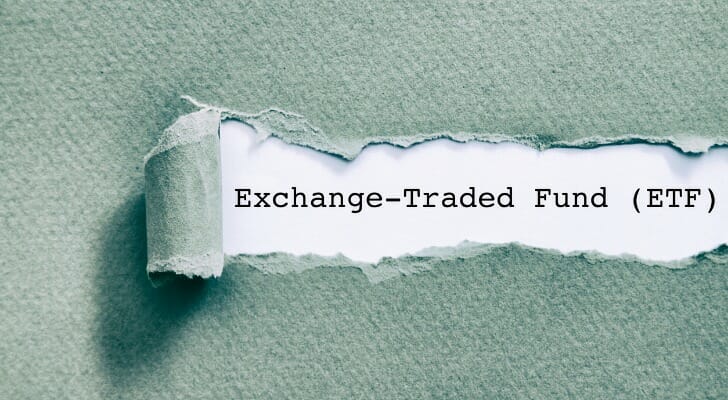As exchange-traded funds (ETFs) and exchange-traded notes (ETNs) continue to grow in popularity, investors often debate the advantages and disadvantages of each. Both options can help diversify a portfolio, but they come with distinct benefits and risks. While ETFs and ETNs share similarities, they also have key differences that are important to understand before making an investment. Consulting with a financial advisor can help you determine whether an ETF vs. ETN aligns with your portfolio diversification goals.
What Is an ETF?
An exchange-traded fund is a financial instrument that represents a basket of assets traded on a stock exchange. Unlike mutual funds, which are only priced at the end of the trading day, ETFs are bought and sold throughout the day just like individual stocks. ETFs are designed to track the performance of a specific market index, making them a popular choice for investors seeking diversified exposure to the stock market.
For instance, some ETFs replicate the performance of the Standard and Poor’s 500 Index (S&P 500) by holding all 500 stocks included in the index. These ETFs offer broad market exposure, allowing investors to capture the returns of large-cap companies across various industries. Alternatively, other ETFs focus on narrower segments of the market, such as the technology sector, international markets or even niche themes like clean energy or emerging markets.
ETFs are not limited to equities; they also cater to alternative investments. There are ETFs that track commodities like gold, silver or oil, as well as those focused on currencies or real estate investment trusts (REITs). This diversity makes ETFs a versatile tool for building a well-rounded investment portfolio.
Additionally, ETFs share some similarities with mutual funds, particularly in how they pool money from multiple investors to purchase a collection of securities. However, their intraday trading flexibility and generally lower expense ratios give ETFs a distinct edge for many investors.
What Is an ETN?
An exchange-traded note, while similar to an ETF in that it trades on a stock exchange, is fundamentally different in structure. Unlike ETFs, which are composed of actual securities like stocks or bonds, ETNs are unsecured debt obligations issued by financial institutions. These notes are designed to provide investors with returns linked to the performance of a specific market index or benchmark.
Think of an ETN as a loan you make to the issuing financial institution. In return, the institution promises to pay you a return based on the performance of the underlying index or asset, minus any management fees. ETNs do not own the assets they track. Instead, their value is tied to the issuer’s creditworthiness. This introduces an additional risk factor known as credit risk. If the issuing institution faces financial difficulties, you might not receive the expected payout.
ETNs share similarities with zero-coupon bonds in that they do not pay interest or dividends during their lifespan. Instead, investors realize their returns at maturity when they receive a payout equal to the index’s performance, adjusted for fees. For instance, an ETN tracking a commodity index might pay out the equivalent of the index’s gains or losses when the note matures.
Similarities Between ETFs and ETNs
Despite their structural differences, ETFs and ETNs share a few key features:
- Exchange-Traded: Both ETFs and ETNs are traded on stock exchanges, providing liquidity and enabling investors to buy or sell throughout the trading day.
- Market Tracking: Both instruments are designed to track the performance of specific indices, sectors, or asset classes.
- Price Fluctuations: The market price of both ETFs and ETNs fluctuates throughout the day based on the performance of the index or asset they are tied to.
However, the choice between an ETF and an ETN often depends on an investor’s objectives, risk tolerance and understanding of the differences in structure and associated risks. While ETFs are generally seen as straightforward and relatively low-risk, ETNs can offer unique advantages for accessing complex or illiquid markets — albeit with the added consideration of credit risk.
Pros and Cons of an ETF

ETFs have gained popularity among investors due to their flexibility, cost-effectiveness and ability to provide diversified exposure to various financial assets. However, like any investment, ETFs come with both advantages and drawbacks. Below is a closer look at the pros and cons of ETFs to help you evaluate whether they align with your investment goals.
Pros of ETFs
ETFs offer several benefits that make them an appealing choice for investors seeking diversification, lower costs and ease of trading. Here are some of their key advantages:
- Diversification: ETFs provide exposure to a wide range of financial assets, from broad market indexes like the S&P 500 to niche sectors like gold mining stocks. This diversification helps spread risk, though it depends on the ETF type.
- Liquidity: ETFs trade on exchanges like stocks, allowing investors to buy and sell them throughout market hours, unlike mutual funds, which settle only at the day’s end.
- Lower Costs: ETFs typically have lower trading fees, expense ratios and management fees compared to mutual funds. Many brokerages also offer commission-free ETF trades.
- Passive Management: Most ETFs are passively managed, tracking specific indexes. This results in fewer capital gain distributions and reduced management fees compared to actively managed mutual funds.
- Ease of Investment: ETFs allow investors to gain exposure to multiple assets without needing the substantial capital required to buy each underlying stock individually.
Cons of ETFs
Despite their many advantages, ETFs also have potential downsides that investors should carefully consider before adding them to their portfolios:
- Tracking Risk: ETFs may not perfectly replicate the performance of their underlying index due to tracking errors, leading to slight deviations in returns.
- Tax Implications: ETFs distribute dividends, interest, and capital gains, which can lead to tax liabilities. Short-term capital gains are taxed at higher rates, and dividends are often taxed as ordinary income. Unlike mutual funds, ETFs do not offer automatic dividend reinvestment.
- Market Risk: ETFs tracking broad indexes are subject to market volatility. If the market declines, the value of the ETF is likely to fall.
Pros and Cons of ETNs
ETNs are a newer financial product designed to provide investors access to various market indexes, including exotic securities and emerging markets. Like ETFs, ETNs trade on stock exchanges and offer unique benefits and risks. Below is an overview of the pros and cons of ETNs to help investors evaluate their suitability.
Pros of ETNs
ETNs offer several advantages that can appeal to investors seeking unique investment opportunities and favorable tax treatment:
- Access to Exotic Securities: ETNs allow investors to gain exposure to specialized markets and securities, such as currencies and foreign markets, which might otherwise be difficult to access.
- Tax Efficiency: Unlike ETFs, ETNs do not pay interest or dividends during their lifetime, offering preferential tax treatment. Investors only pay long-term capital gains tax if held for more than one year or short-term capital gains tax if held for less than a year.
- Maturity Redemption: ETNs can be redeemed at maturity for the value of the underlying market index or sold in the open market before maturity. This flexibility allows investors to align with their financial goals.
- Profit Potential: Investors profit if the ETN’s sales price exceeds the value of the market index it tracks at redemption or sale.
Cons of ETNs
Despite their benefits, ETNs carry significant risks that investors should consider before committing to this investment:
- Credit Risk: ETNs are directly affected by the creditworthiness of the issuing institution. A downgrade in the institution’s credit rating can reduce the ETN’s value, even if the underlying index remains stable.
- Liquidity Risk: Since the ETN market is less robust than other markets, finding buyers can be challenging, leading to potential liquidity issues. Investors may need to sell at a premium or discount.
- Default Risk: ETNs are unsecured debt instruments. If the issuing financial institution defaults or cannot repay the principal, investors may face significant losses with limited recourse.
- Call Risk: Issuers can redeem ETNs before maturity. If called at a lower price than the purchase price, investors incur losses.
- Tracking Risk: ETNs may not perfectly mirror the performance of the index they track. Proprietary or less transparent indexes can amplify this risk, potentially resulting in losses.
Bottom Line

ETFs are baskets of securities bundled and tracked against a market index. ETFs suffer from the tax regime they have to follow. ETNs are debt instruments issued by financial institutions. They also track a market index, but they are much more like bonds even though they don’t pay interest. The market for ETNs can be illiquid since they have not reached the popularity of ETFs. ETNs also carry a credit risk.
Tips on Investing
- Consider working with a financial advisor as you consider what types of funds are most appropriate for your goals, timeline and risk profile. Finding a financial advisor doesn’t have to be hard. SmartAsset’s free tool matches you with vetted financial advisors who serve your area, and you can have a free introductory call with your advisor matches to decide which one you feel is right for you. If you’re ready to find an advisor who can help you achieve your financial goals, get started now.
- Use the SmartAsset capital gains calculator to help determine your tax position.
Photo credit: ©iStock.com/fizkes, ©iStock.com/1001Love, ©iStock.com/G0d4ather
